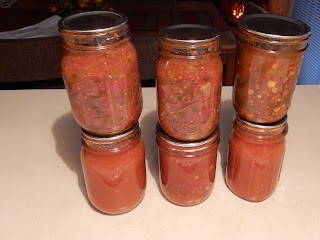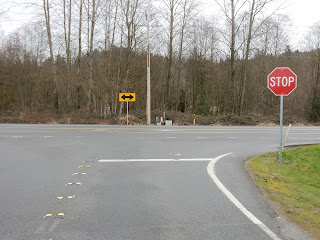The other day while rummaging through a folder of odds and ends, articles, newspaper clippings, and various print curiosities I've salted away over the years, I happened upon a cartoon. It works upon a familiar theme of cartoonists: two castaways on a desert isle, and as is the case with my discovery, a husband and wife. Barefoot and disheveled, the couple are wiling away their time on a small bulge of sand barely above sea level. Waves nibble at the tideline nearly licking their toes. Remnants of a doomed vessel, the "SS Banana": life rings, an oar, partial skeleton of hull litter the fringes of the tiny sandpile. A starfish (plus a distant pair of seabirds) are the only other visible life. The husband, peppered with beard, is roasting a fish over a small fire as if it were a marshmallow. Sprawled behind him like the hag of the sea, his missus (given her portly figure, it's obvious the seafood diet has yet to take effect) has her own priorities: "It will soon be Christmas," she says, "When are you going to get a tree?"
Aside from the desert isle scenario, hers is a question much on our minds this time of the year, and it prompted me to ask my missus if the tree of the season wasn't our fifty-second. "The fifty-third," she replied. "Our first Christmas tree was in my apartment, the one we shared after we were married." I had forgotten. Ah, yes, betrothed we were when we enjoyed that first tree. Nine days after Christmas we were married.
I think of them now, those Christmas trees.... Fifty-three Douglas firs, always Doug fir, our holiday icon of choice. Today, had they remained rooted in the soil of their planting, not severed and dragged indoors, the lot of them would make a small forest, a teeming ecosystem, fir-fragrant cover for forest animals and birds, a quiet sanctum in which the pensive hiker could escape the tumult of the world. But for our fifty-three that was not to be. They were destined to become a forest of another sort, a forest of memories.
There was that tree I purchased from a lot and carried several blocks to our Seattle apartment to make amends over a falling out we had about Christmas, its stress, and our tight budget. And then that tree whose trunk a lightning bolt would have been hard pressed to trace--our "scoliosis Christmas tree" we called it. We've had trees so tall they scraped the vaulted ceiling of our rec room, had to be wired to the wall to prevent toppling. And there were trees whose needles dropped less than a week into their indoor Christmas journey, transforming our carpet into the duff of a forest floor. One tree, if memory serves, had to be brought indoors to thaw when its trunk, submerged in a five gallon bucket, froze solid during a cold snap.
Of our holiday forest only one tree came from the wilderness. That was the year we spent in a rented cabin on the sparsely inhabited fringe of the North Cascades Wilderness. A dollar bought us a Forest Service permit to seek out and cut the tree of our choice.
One day at dusk we trudged up a snow laden hillside (where our tracks intersected those of a roaming cougar) to a small clump of firs, each dwarfed it seemed by their towering Ponderosa pine neighbors and bagged the perfect tree for our Christmas. Our prize nearly swallowed up our VW bug and fir-camouflaged we plowed our way back to our cabin where we had to lop off nearly one-third of the tree to make it fit the low ceilings.
After our friend Dick Hetland presumed himself a conifer connoisseur and carted home his pick of the lot, wife Nan exercised her veto, demanded he discard the ugly thing, select another and reminded him in the future that tree selection was a joint venture. Dick and Nan's polarity in artistic tastes ushered in a period when the Hetlands and our family drove our daughters to neighboring tree farms where after considerable scrutiny, wind chill exposure, and ring-around-the rosy with each and every tree in the grove was the saw employed, the season's "perfect" tree selected.
In the past we have bartered for trees from Dale Reiner's tree lots (To Tree or not to Tree), the Doug fir of our choice in exchange for a quart of local honey gathered in the Valley by my industrious bees. These days, however, we select the season's centerpiece from local box stores, each year crossing our fingers that our choice will last the season without denuding itself and embarrassing the household, thus putting us on par with our friends the Hetlands and what we jokingly termed their "tree of the week" protocol.
Now the tree is in its stand and perpendicular--not plumb bob perpendicular, perhaps--but to the eyes of the householders close enough.
Next come the ornaments one by one, each in itself an attic-archived memory. There's the Micky Mouse medallion from Disney World. The silver-tarnished pine cone from Wallace, Idaho, a stopover to and from "The Field of Dreams." The frosted orb from the Southern Ute Reservation in Ignacio, Colorado, a literature inspired bucket list destination.
The Welsh Corgi angel dog, in memory of a pet. The candy-apple red glittered "kinky boot" from my cousin, a shoe salesman at Nordstrom's. Delicate snowflakes crocheted by mother-in-law, her memory preserved in each loving stitch. A pair of miniature mittens, crocheted with blue yarn...blue...a boy, the first grandchild. The golden heart ornament we "filched" (with our waiter's permission--and blessing) from a holiday tree in the window of Seattle's Icon Grill, a gilded memento of our fiftieth wedding anniversary.
The photo ornaments which spotlight and chronicle our daughter's journey across her many Christmases with us. Tradition dictates her ornament be the first hung on the tree each year, an elementary school art project in the likeness of a pear, a marvel in paper mache slathered one coat upon the next in yellow tempera.
And so down the years each Christmas tree serves up for us all a memory of its own, adds its uniqueness to that forest, a forest of memories, wood fuel to fire the nostalgia of Christmases past, gifts that need no wrapping.
* * * *
Once a car stops and the rich mill owner's lazy wife leans out and whines:
"Giveya two-bits cash for that ol tree."
Ordinarily my friend is afraid of saying no; but on this occasion she promptly shakes her head: "We wouldn't take a dollar."
The mill owner's wife persists. "A dollar, my foot! Fifty cents. That's my last offer. Goodness, woman, you can get another one."
In answer, my friend gently reflects: "I doubt it. There's never two of anything."
Truman Capote's Aunt Sook in A Christmas Memory
Editor's note: In the course of composing this post, the tree-laden VW ornament pictured above accidentally slipped from my hand during its photo session, hit the floor and shattered to pieces. The ornament was a gift from my mother. Years ago she happened upon the ornament and because it reminded her of our wilderness tree hunt and tree-smothered car, presented it to us that Christmas. Now the ornament itself has sadly passed into memory and cast a bittersweet cloud over this post.










































